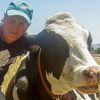Click here to watch the TEDTalk that inspired this post.
Carin Bondar's phenomenal and learned TED talk called "The Birds And The Bees Are Just the Beginning" is one of most informative lectures I've heard in a long time. Her tongue-in-cheek style is extremely engaging and clearly she enjoys what she does. And, she isn't kidding when she notes that if we only studied birds and bees we'd lose a ton of very interesting information about the sex lives of other animals, many of whom were unfamiliar to me.
One size doesn't fit all
The essence of Dr. Bondar's presentation is that there is a lot of diversity in sexual behavior and anatomy among nonhuman animals (animals) and that "one size fits all" explanations don't work. We learn, for example, that paper nautilus males have a detachable swimming penis that once was thought to be a distinct organism, rather than an organ, and that some penises are huge beyond imagination when scaled to the size of a male's body. The roving swimming penis finds females using pheromones (chemicals). And, it turns out, that bed bug sex is incredibly traumatic because of the male's barbed penis that he stabs anywhere on the female's body to impregnate her. He goes from flaccid to ejaculation in less than one second. Vaginas and clitorises also come (no pun intended) in a wide variety of shapes and sizes. I wonder what Alfred Kinsey would have thought about all of this?
I've long been interested in the evolution of different aspects of social behavior, a topic that I cover in my recent book called Why Dogs Hump and Bees Get Depressed. As I listened to Dr. Bondar I wondered if evolutionary biology could shed light on what some people consider to be "kinky", loosely defined as some form of unusual or unconventional sex that is considered to be abnormal (and embarrassing). I immediately thought that perhaps we really don't know what is unusual or unconventional because surveys about human sexual behavior may be replete with inaccurate reports of what people really do in bed, on couches, in telephone booths, or on kitchen counters. A web search confirmed my suspicion that sex surveys may not actually tell us what people consider conventional or kinky or what their intimate lives truly are like.
You drive me batty!
It's clear that other animals aren't as inhibited as humans when they want to get it on in one way or another. After watching Dr. Bondar's talk I thought about oral sex in animals, something that I can't recall having crossed my mind even after having watched thousands of interactions in dogs, coyotes, and wolves in which a good deal of attention - both sniffing and licking -- is paid to another individual's genital area. I wondered if we're the only animals who engage in fellatio or cunnilingus. So, I did a web search for "oral sex in nonhuman animals" and I found more than 13 million hits! Once again there are problems with definition because different people define oral sex differently, ranging from oral-genital contact to stimulation that feels good to stimulation resulting in orgasm. Regardless, it's pretty clear that oral sex involves a mouth.
What I found was very interesting and new to me. There have been observations of oral sex among nonhuman primates including baboons and bonobos. Bats too do it. In fruit-eating Indian flying foxes it's been shown that cunnilingus as foreplay is a major part of their sexual repertoire and that it makes sex last longer. Males get about an extra two seconds of penetration if they perform cunnilingus for 15 seconds before entering the female.
In the short-nosed fruit bat fellatio has been observed even during copulation. I wonder if these examples of oral sex in bats are where the phrase, "You drive me batty" (where batty means insane or crazy) comes from? Is it rooted in evolutionary biology?
Is it kinky or not?
Depending on one's take on what's kinky or not, oral sex is unconventionally kinky or "yucky" or normal sexual behavior. If one wants to look to evolutionary biology to tell us what's kinky or not, it's clear there's a lot of what we would call "kinkiness" among nonhuman animals so for something to be really kinky it would have to be an act that goes beyond standard ranges of imagination. We have pretty narrow definitions of sex when compared to other animals.
So, yes, I think evolutionary biology can help us understand what's kinky and what's not. I think of the bumper sticker for evolutionary continuity to go something like, "If we have or do something, 'they' (other animals) have it or do it too."
And, judging from the incredible variability and broad range of sexual behavior among nonhuman animals for which Dr. Bondar's lecture gave us but a small taste, one better get ready for a wild ride if they're going to outdo what we know about the sex lives of the fascinating animals with whom we share different niches on our magnificent planet. We can learn a lot from them, but I'm not sure the reverse is true.
Ideas are not set in stone. When exposed to thoughtful people, they morph and adapt into their most potent form. TEDWeekends will highlight some of today's most intriguing ideas and allow them to develop in real time through your voice! Tweet #TEDWeekends to share your perspective or email tedweekends@huffingtonpost.com to learn about future weekend's ideas to contribute as a writer.
